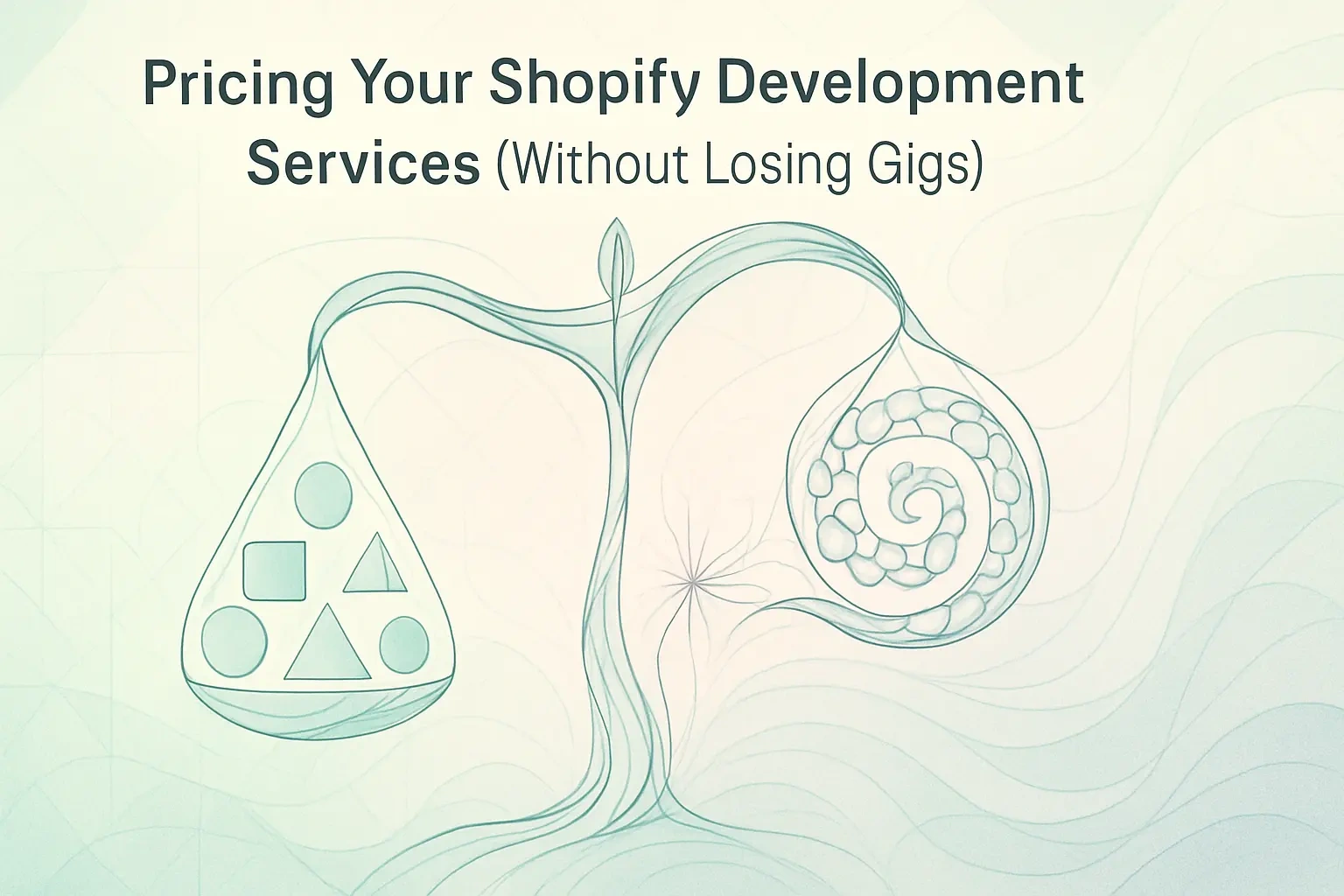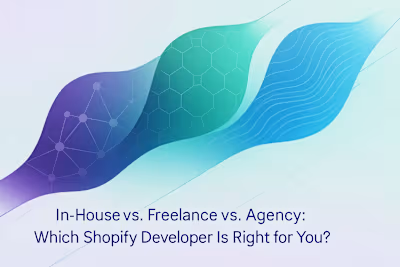Pricing Your Shopify Development Services (Without Losing Gigs)

Pricing Your Shopify Development Services (Without Losing Gigs)
Understanding Different Pricing Models
The Hourly Rate Model: Pros and Cons
Project-Based Pricing: Delivering Value
The Retainer Model: Building Long-Term Relationships
Factors That Influence Your Pricing
Your Experience and Expertise Level
Project Complexity and Scope
Geographic Location and Market Rates
Communicating Your Price to Clients
Creating Professional and Transparent Proposals
How to Handle Price Objections
When to Be Flexible and When to Stand Firm
References
Pricing Your Shopify Development Services (Without Losing Gigs)
Setting the right price for your Shopify development services is a balancing act. Price too high, and you might scare away potential clients. Price too low, and you're undervaluing your expertise and leaving money on the table. This guide will demystify the process, helping you choose the right pricing strategy for your skills and experience. After all, once you've found the best platforms to launch your career, you need to be prepared to talk numbers. A well-priced proposal, backed by a powerful portfolio, is your ticket to success.
The freelance market is filled with talented developers, but not all of them know how to price their work effectively. Many expert Shopify developers started out charging too little, then gradually learned to value their skills appropriately. This guide will help you skip that painful learning curve and start pricing your services confidently from day one.
Understanding Different Pricing Models
There's no one-size-fits-all approach to pricing. The model you choose will depend on the project's scope, the client's needs, and your own business goals. This section explores the most common pricing structures used by freelance Shopify developers.
Each pricing model has its sweet spot. Some work better for quick fixes and small tweaks. Others shine when you're building complex custom solutions. The key is matching the right model to the right project – and knowing when to suggest an alternative that works better for both you and your client.
The Hourly Rate Model: Pros and Cons
The hourly model is straightforward and ensures you're paid for all your time. We'll discuss when it's most appropriate, how to set a competitive hourly rate based on experience and location, and the importance of time tracking.
Charging by the hour feels natural when you're starting out. You work, you get paid – simple as that. But here's what many developers don't realize: hourly pricing can actually work against you as you get more efficient. Think about it. If you can build a custom product page in two hours instead of six, should you really earn less money for delivering the same value?
That said, hourly rates work great for certain situations. When a client needs ongoing support or wants you available for quick fixes, hourly billing makes sense. It's also perfect for projects where the scope keeps changing. You know those clients who say "just one more small change" every other day? Hourly billing protects you from scope creep.
So what should you charge per hour? According to recent data, Shopify developers in the US charge anywhere from $25 to $150+ per hour. Entry-level developers typically start around $25-40, while experienced pros command $75-150 or more. Your location matters too. Developers in major tech hubs often charge more than those in smaller markets.
Time tracking is crucial when you bill hourly. Use tools like Toggl or Harvest to track every minute you spend on client work. Be transparent about what counts as billable time. Does research count? What about client calls? Set these expectations upfront to avoid awkward conversations later.
Project-Based Pricing: Delivering Value
Fixed-price projects are attractive to clients because they know the total cost upfront. This subsection will cover how to accurately scope a project, calculate a profitable fixed price, and handle scope creep.
Project-based pricing shifts the focus from time to results. Instead of selling hours, you're selling outcomes. A client doesn't really care if their new collection page takes you 10 hours or 20 hours to build. They care about getting a page that converts visitors into buyers.
The trick with fixed pricing? You need to become a master at scoping projects. Start by breaking down every project into specific deliverables. Don't just say "build a custom theme." List out exactly what that includes. How many page templates? Which features? What about mobile optimization? The more detailed your scope, the fewer surprises you'll face.
Here's a simple formula for calculating project prices: estimate your hours, multiply by your desired hourly rate, then add a buffer. That buffer is important. Projects almost always take longer than expected. Add at least 20% to cover unexpected challenges and revision requests.
Scope creep is the enemy of profitable project pricing. You know how it goes. You agree to build five page templates, then suddenly the client wants "just a quick popup" or "a small tweak to the checkout." These small requests add up fast. The solution? Put everything in writing. Create a detailed project agreement that lists exactly what's included and what's not. When clients request changes, offer them as paid add-ons.
Many successful Shopify developers use project packages to simplify their pricing. For example, you might offer a "Starter Store Setup" for $2,500 that includes theme installation, basic customization, and five product listings. Or a "Custom Theme Build" starting at $5,000. Packages make it easier for clients to understand what they're buying.
The Retainer Model: Building Long-Term Relationships
Retainers provide a steady, predictable income stream. Learn how to structure a retainer agreement, what services to include, and how this model can lead to more stable client partnerships.
Imagine getting paid the same amount every month, whether you work 10 hours or 30. That's the beauty of retainer agreements. They transform the feast-or-famine freelance cycle into something more like a regular paycheck.
Retainers work best with clients who need ongoing support. Maybe they're constantly launching new products, running seasonal campaigns, or just want someone on call for updates and fixes. Instead of billing for each small task, you agree on a monthly fee that covers a certain level of service.
Start small when proposing retainers. Offer a basic package that includes, say, 10 hours of development time per month plus priority support. Price it slightly below your normal hourly rate to make it attractive. As clients see the value, you can expand the retainer to include more services.
What should a retainer include? Think beyond just development hours. You might offer monthly performance reviews, security updates, conversion optimization suggestions, or training for their team. The goal is to become their go-to Shopify expert, not just another developer.
Structure your retainer agreements carefully. Specify what happens to unused hours (do they roll over?), how quickly you'll respond to requests, and what work falls outside the retainer. Some developers offer different tiers – a basic maintenance package, a growth package with more hours, and a premium package with dedicated support.
The best part about retainers? They change your relationship with clients. Instead of being the person they call when something breaks, you become a strategic partner in their business growth. You'll spot opportunities they miss and fix problems before they even notice them.
Factors That Influence Your Pricing
Your pricing should reflect more than just the time you spend on a project. This section delves into the various factors you should consider when determining the value of your services.
Think of pricing like a recipe. Time is just one ingredient. You also need to factor in your expertise, the project's complexity, and what the market will bear. Miss any of these ingredients, and your pricing won't taste quite right to either you or your clients.
Your Experience and Expertise Level
A senior developer with years of experience and specialized skills can command a much higher rate than a beginner. We'll discuss how to position your expertise to justify premium pricing.
Experience isn't just about years in the game. It's about the problems you've solved and the value you can deliver. A developer who's built 50 basic Shopify stores might have less valuable experience than someone who's created five complex, high-converting custom solutions.
Track your wins to justify higher rates. Did you help a client increase their conversion rate by 30%? Build that into your pricing story. Have you developed custom apps that solve specific industry problems? That specialized knowledge commands premium rates.
Don't underestimate the value of soft skills either. Can you explain technical concepts in plain English? Do you deliver projects on time without constant supervision? These skills matter just as much as your coding ability. Clients pay extra for developers who make their lives easier.
Consider creating a skills matrix for yourself. List out your technical skills (Liquid, JavaScript, React, etc.) and rate your proficiency. Then add your industry knowledge, soft skills, and unique experiences. This exercise helps you see where you provide the most value – and where you can charge accordingly.
As you gain experience, raise your rates gradually. A good rule of thumb? Increase your rates by 10-20% every six months as you're starting out. Once you're established, adjust based on demand. If you're booked solid for months, you're probably undercharging.
Project Complexity and Scope
A simple theme customization should be priced differently than a custom app development project. This part will cover how to assess the complexity of a project and price it accordingly.
Not all Shopify projects are created equal. Installing a pre-made theme and adding a logo? That's a few hours of work. Building a custom subscription box system with personalized product recommendations? That's a whole different beast.
Learn to spot complexity red flags during initial conversations. When clients use phrases like "it should be simple" or "just like Amazon, but different," your complexity radar should start beeping. The more custom functionality they want, the higher your price should climb.
Break down complexity into categories. Technical complexity includes custom coding, API integrations, and performance optimization. Design complexity covers unique layouts, animations, and responsive challenges. Business complexity involves multiple stakeholders, compliance requirements, or integration with existing systems.
Create a complexity multiplier for your base rates. A simple theme tweak might be 1x your normal rate. A moderate customization could be 1.5x. Complex custom development? That might be 2x or even 3x your base. This system helps you price consistently while accounting for project difficulty.
Don't forget about hidden complexity. A "simple" feature might require extensive testing across devices. That "quick" integration might need documentation and training. Factor these hidden tasks into your pricing from the start.
Geographic Location and Market Rates
Developer rates can vary significantly by region. We will look at average rates in different markets and discuss how to price your services competitively whether you're working with local or international clients.
Location matters, but maybe not as much as you think. Yes, a developer in San Francisco might charge $150/hour while someone in a smaller city charges $50. But in the remote work era, these boundaries are blurring. What matters more is the value you deliver and the clients you target.
Research your local market if you're targeting nearby businesses. Check what agencies charge, browse freelance job boards, and maybe even mystery shop a few competitors. This gives you a baseline for local expectations. But don't let local rates limit you if you're offering exceptional value.
When working with international clients, price based on value, not your location. A US-based e-commerce brand doesn't care if you're in New York or Nicaragua. They care about results. If you can deliver the same quality as a high-priced developer, you can charge accordingly.
Consider creating different rate cards for different markets. You might charge premium rates for enterprise clients while offering competitive prices for local small businesses. This isn't about being unfair – it's about matching your prices to what different markets value and can afford.
Currency and payment methods matter too. When working internationally, quote in the client's currency when possible. Use payment platforms that make international transfers easy. And always factor in payment processing fees and currency conversion costs.
Communicating Your Price to Clients
How you present your pricing is just as important as the numbers themselves. This section provides tips for confidently communicating your value and negotiating with clients.
Picture this: you've calculated the perfect price for a project. It's fair, profitable, and reflects your expertise. But when you share it with the client, you stumble over your words, apologize for the cost, and immediately offer a discount. Sound familiar? Let's fix that.
Creating Professional and Transparent Proposals
A detailed proposal that breaks down the costs and deliverables builds trust and justifies your price. Learn what to include in your proposals to increase your chances of winning the project.
Your proposal is more than a price quote. It's a sales document that demonstrates your professionalism and understanding of the client's needs. Start with their problem, not your solution. Show them you get what they're trying to achieve.
Structure your proposals for clarity. Begin with a project summary that reflects back what the client told you. Then outline your proposed solution, breaking it into clear phases or milestones. Only then should you present the investment required. This order helps clients see the value before they see the price.
Be specific about deliverables. Instead of "e-commerce setup," list "Installation and configuration of premium theme, setup of 5 main collections, creation of 20 product listings with SEO optimization, and mobile responsiveness testing across 5 devices." Specificity justifies your pricing and prevents misunderstandings.
Include a timeline that shows when each phase will be completed. Clients love knowing when they'll see results. Add payment terms too – whether you want 50% upfront, payment by milestone, or net 30 terms. Clear expectations prevent awkward money conversations later.
Don't forget the extras that set you apart. Maybe you include a month of post-launch support, training videos for their team, or performance optimization. These value-adds help justify your rates and show you're thinking beyond just the build.
How to Handle Price Objections
It's common for clients to question your pricing. This subsection will equip you with strategies for responding to objections, focusing on the value you provide rather than just the cost.
"That's more than I expected." Every freelancer has heard these words. Your stomach drops, and you want to immediately slash your price. Stop. Take a breath. Price objections are normal, and they don't mean you've lost the project.
First, understand what's behind the objection. Are they comparing you to cheaper options? Did they have an unrealistic budget? Or are they just negotiating? Ask questions like "What price range were you considering?" or "What's most important to you in this project?" Their answers guide your response.
Shift the conversation from cost to value. If they balk at your $5,000 quote, remind them that a well-built store can generate hundreds of thousands in revenue. Frame your fee as an investment, not an expense. Share examples of results you've achieved for similar clients.
Offer options instead of discounts. Rather than cutting your rate, suggest a scaled-back version of the project. "We could start with the essential features for $3,000, then add the advanced functionality in phase two." This approach maintains your value while giving them control.
Sometimes the objection isn't really about price. They might be worried about risk. Address this with guarantees, payment plans, or a smaller starter project. Show them you're confident in your ability to deliver results.
When to Be Flexible and When to Stand Firm
Negotiation is part of the freelance game. We'll discuss how to identify opportunities for flexibility without devaluing your work and when it's best to walk away from a project that isn't a good fit.
Flexibility doesn't mean being a pushover. It means knowing when bending a little leads to a better outcome for everyone. Maybe you offer a small discount for a longer-term commitment. Or you adjust the project scope to fit their budget while maintaining your hourly value.
Look for win-win opportunities. If a client needs a lower price, can they offer something else of value? Maybe they'll provide a glowing testimonial, refer you to their network, or pay the full amount upfront. These trades can be worth more than the discount you're giving.
But some lines shouldn't be crossed. Never work for free "for exposure." Don't accept payment terms that put your business at risk. And definitely don't take on clients who don't respect your expertise or process. These projects rarely end well, no matter the price.
Know your walk-away point before any negotiation. What's the minimum you need to make the project worthwhile? Factor in not just the money, but the opportunity cost, the stress level, and the impact on your reputation. Sometimes the best deal is the one you don't make.
Red flags that signal it's time to stand firm or walk away: clients who immediately ask for huge discounts, those who compare you to offshore developers charging $10/hour, or anyone who says "it should only take you an hour." These clients rarely value quality work.
Remember, every time you accept a bad deal, you're not just losing money on that project. You're setting a precedent, taking time away from better opportunities, and potentially damaging your confidence. Your rates reflect your value. Believe in them, communicate them clearly, and the right clients will happily pay them.
Pricing your Shopify development services doesn't have to be a guessing game. Start with a clear understanding of different pricing models and what works best for your style. Factor in your experience, project complexity, and market rates. Then communicate your value confidently, handle objections professionally, and know when to be flexible versus when to stand your ground.
The developers who thrive aren't always the most technically skilled. They're the ones who price their services appropriately, deliver consistent value, and build lasting client relationships. With the strategies in this guide, you're ready to join their ranks. Now stop undervaluing yourself and start charging what you're worth.
References
Like this project
Posted Jul 4, 2025
Struggling to price your Shopify development services? Learn about different pricing models like hourly, project-based, and retainers to confidently charge what you're worth and win more projects.








